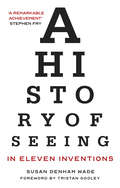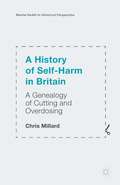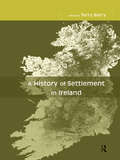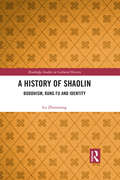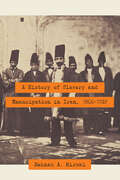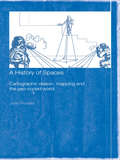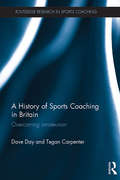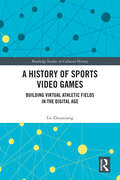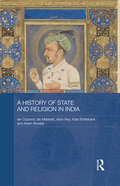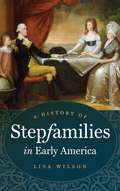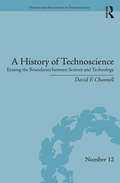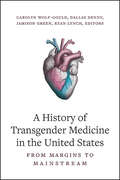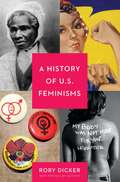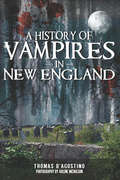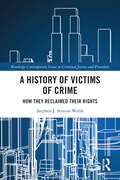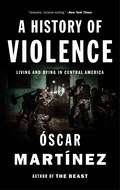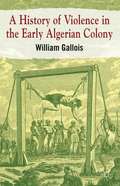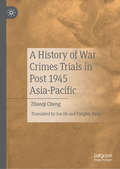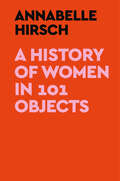- Table View
- List View
A History of Regional Commercial Television in Australia
by Michael ThurlowThis book is the first history of commercial television in regional Australia, where diverse communities are spread across vast distances and multiple time zones. The first station, GLV Latrobe Valley, began broadcasting in December 1961. By the late 1970s, there were 35 independent commercial stations throughout regional Australia, from Cairns in the far north-east to Bunbury in the far south-west. Based on fine-grained archival research and extensive interviews, the book examines the key political, regulatory, economic, technological, industrial, and social developments which have shaped the industry over the past 60 years. Regional television is often dismissed as a mere extension of – or footnote to – the development of Australia’s three metropolitan commercial television networks. Michael Thurlow’s study reveals an industry which, at its peak, was at the economic and social heart of regional communities, employing thousands of people and providing vital programming for viewers in provincial cities and small towns across Australia.
A History of Seeing in Eleven Inventions: A History of Seeing
by Tristan Gooley Susan Denham Wade'A remarkable achievement' - Stephen FryIn 2015 #thedress captured the world’s imagination. Was the dress in the picture white and gold or blue and black? It inspired the author to ask: if people in the same time and place can see the same thing differently, how did people in distant times and places see the world?Jam-packed with fascinating stories, facts and insights and impeccably researched, A History of Seeing in Eleven Inventions investigates the story of seeing from the evolution of eyes 500 million years ago to the present day. Time after time, it reveals, inventions that changed how people saw the world ended up changing it altogether.Twenty-first-century life is more visual than ever, and seeing overwhelmingly dominates our senses.Can our eyes keep up with technology? Have we gone as far as the eye can see?
A History of Self-Harm in Britain: A Genealogy of Cutting and Overdosing (Mental Health in Historical Perspective)
by Chris MillardThis book is open access under a CC BY license and charts the rise and fall of various self-harming behaviours in twentieth-century Britain. It puts self-cutting and overdosing into historical perspective, linking them to the huge changes that occur in mental and physical healthcare, social work and wider politics.
A History of Settlement in Ireland
by Terry BarryA History of Settlement in Ireland provides a stimulating and thought-provoking overview of the settlement history of Ireland from prehistory to the present day. Particular attention is paid to the issues of settlement change and distribution within the contexts of:* environment* demography* culture.The collection goes further by setting the agenda for future research in this rapidly expanding area of academic interest.This volume will be essential reading for all those with an interest in the archaeology, history and social geography of Ireland.
A History of Shaolin: Buddhism, Kung Fu and Identity (Routledge Studies in Cultural History #70)
by Lu ZhouxiangShaolin Monastery at Mount Song is considered the epicentre of the Chan school of Buddhism. It is also well known for its martial arts tradition and has long been regarded as a special cultural heritage site and an important symbol of the Chinese nation. This book is the first scholarly work in English to comprehensively examine the full history of Shaolin Monastery from 496 to 2016. More importantly, it offers a clear grasp of the origins and development of Chan Buddhism through an examination of Shaolin, and highlights the role of Shaolin and Shaolin kung fu in the construction of a national identity among the Chinese people in the past two centuries.
A History of Shaolin: Buddhism, Kung Fu and Identity (Routledge Studies in Cultural History #70)
by Lu ZhouxiangShaolin Monastery at Mount Song is considered the epicentre of the Chan school of Buddhism. It is also well known for its martial arts tradition and has long been regarded as a special cultural heritage site and an important symbol of the Chinese nation. This book is the first scholarly work in English to comprehensively examine the full history of Shaolin Monastery from 496 to 2016. More importantly, it offers a clear grasp of the origins and development of Chan Buddhism through an examination of Shaolin, and highlights the role of Shaolin and Shaolin kung fu in the construction of a national identity among the Chinese people in the past two centuries.
A History of Slavery and Emancipation in Iran, 1800–1929
by Behnaz A. MirzaiThe first history of slavery in this key Middle Eastern country and how it shaped the nation&’s unique character.Slavery in the Middle East is a growing field of study, but the history of slavery in a key country, Iran, has never before been written. This history extends to Africa in the west and India in the east, to Russia and Turkmenistan in the north, and to the Arab states in the south. As the slave trade between Iran and these regions shifted over time, it transformed the nation and helped forge its unique culture and identity. Thus, a history of Iranian slavery is crucial to understanding the character of the modern nation.Drawing on extensive archival research in Iran, Tanzania, England, and France, as well as fieldwork and interviews in Iran, Behnaz A. Mirzai offers the first history of slavery in modern Iran from the early nineteenth century to emancipation in the mid-twentieth century. She investigates how foreign military incursion, frontier insecurity, political instability, and economic crisis altered the patterns of enslavement, as well as the ethnicity of the slaves themselves. Mirzai&’s interdisciplinary analysis illuminates the complex issues surrounding the history of the slave trade and the process of emancipation in Iran, while also giving voice to social groups that have never been studied: enslaved Africans and Iranians. Her research builds a clear case that the trade in slaves was inexorably linked to the authority of the state. During periods of greater decentralization, slave trading increased, while periods of greater governmental autonomy saw more freedom and peace.&“This is a major contribution to the study of enslavement in Iran, which will doubtlessly become a must-read for any future studies of Middle Eastern and Islamic enslavement and abolition, as well as for any work on Iranian history in general.&” —Ehud R. Toledano, Tel Aviv University, author of As If Silent and Absent: Bonds of Enslavement in the Islamic Middle East&“While this book will be revelatory to scholars of Iran, it also promises to engage with theoretical trends in the study of slavery elsewhere. It frames many research questions broadly to engage with scholars of slavery in other Muslim lands, as well as slavery elsewhere.&” —Kamran Scot Aghaie, University of Texas at Austin, coeditor of Rethinking Iranian Nationalism and Modernity
A History of Social Justice and Political Power in the Middle East: The Circle of Justice From Mesopotamia to Globalization
by Linda T. DarlingFrom ancient Mesopotamia into the 20th century, "the Circle of Justice" as a concept has pervaded Middle Eastern political thought and underpinned the exercise of power in the Middle East. The Circle of Justice depicts graphically how a government’s justice toward the population generates political power, military strength, prosperity, and good administration. This book traces this set of relationships from its earliest appearance in the political writings of the Sumerians through four millennia of Middle Eastern culture. It explores how people conceptualized and acted upon this powerful insight, how they portrayed it in symbol, painting, and story, and how they transmitted it from one regime to the next. Moving towards the modern day, the author shows how, although the Circle of Justice was largely dropped from political discourse, it did not disappear from people’s political culture and expectations of government. The book demonstrates the Circle’s relevance to the Iranian Revolution and the rise of Islamist movements all over the Middle East, and suggests how the concept remains relevant in an age of capitalism. A "must read" for students, policymakers, and ordinary citizens, this book will be an important contribution to the areas of political history, political theory, Middle East studies and Orientalism.
A History of Spaces: Cartographic Reason, Mapping and the Geo-Coded World
by John PicklesThis book provides an essential insight into the practices and ideas of maps and map-making. It draws on a wide range of social theorists, and theorists of maps and cartography, to show how maps and map-making have shaped the spaces in which we live.Going beyond the focus of traditional cartography, the book draws on examples of the use of maps from the sixteenth century to the present, including their role in projects of the national and colonial state, emergent capitalism and the planetary consciousness of the natural sciences. It also considers the use of maps for military purposes, maps that have coded modern conceptions of health, disease and social character, and maps of the transparent human body and the transparent earth.
A History of Sports Coaching in Britain: Overcoming Amateurism (Routledge Research in Sports Coaching)
by Dave Day Tegan CarpenterAt the London Olympics in 2012 Team GB achieved a third place finish in the medals table. A key factor in this achievement was the high standard of contemporary British sports coaching. But how has British sports coaching transitioned from the amateur to the professional, and what can the hitherto under-explored history of sports coaching in Britain tell us about both the early history of sport and about contemporary coaching practice? A History of Sports Coaching in Britain is the first book to attempt to examine the history of British sports coaching, from its amateur roots in the deep nineteenth century to the high performance, high status professional coaching cultures of today. The book draws on original primary source material, including the lost coaching lives of key individuals in British coaching, to trace the development of coaching in Britain. It assesses the continuing impact of the nineteenth-century amateur ethos throughout the twentieth century, and includes important comparisons with developments in international coaching, particularly in North America and the Eastern Bloc. The book also explores the politicisation of sport and the complicated interplay between politics and coaching practice, and illuminates the origins of the structures, organisations and philosophies that surround performance sport in Britain today. This book is fascinating reading for anybody with an interest in the history of sport, sports coaching, sports development, or the relationships between sport and wider society.
A History of Sports Video Games: Building Virtual Athletic Fields in the Digital Age (Routledge Studies in Cultural History)
by Lu ZhouxiangThis book explores the history of sports and sports-themed video games, providing a comprehensive and holistic view of this complex and diverse genre.The author highlights the influence of technological advancement, industry competition and popular culture on game design, marketing strategies and user experience. Offering valuable insights into the historical process of interaction and integration between real-world sport and video games, this volume will enrich existing scholarship on video games.This volume is a valuable contribution to the fields of both game studies and sports studies, and will be perfect for those interested in the history of science and technology as well as social and cultural history.
A History of State and Religion in India (Routledge Studies in South Asian History)
by Asim Roy Ian Copland Ian Mabbett Kate Brittlebank Adam BowlesOffering the first long-duration analysis of the relationship between the state and religion in South Asia, this book looks at the nature and origins of Indian secularism. It interrogates the proposition that communalism in India is wholly a product of colonial policy and modernisation, questions whether the Indian state has generally been a benign, or disruptive, influence on public religious life, and evaluates the claim that the region has spawned a culture of practical toleration. The book is structured around six key arenas of interaction between state and religion: cow worship and sacrifice, control of temples and shrines, religious festivals and processions, proselytising and conversion, communal riots, and religious teaching/doctrine and family law. It offers a challenging argument about the role of the state in religious life in a historical continuum, and identifies points of similarity and contrast between periods and regimes. The book makes a significant contribution to the literature on South Asian History and Religion.
A History of Stepfamilies in Early America
by Lisa WilsonStepfamilies are not a modern phenomenon, but despite this reality, the history of stepfamilies in America has yet to be fully explored. In the first book-length work on the topic, Lisa Wilson examines the stereotypes and actualities of colonial stepfamilies and reveals them to be important factors in early United States domestic history. Remarriage was a necessity in this era, when war and disease took a heavy toll, all too often leading to domestic stress, and cultural views of stepfamilies during this time placed great strain on stepmothers and stepfathers. Both were seen either as unfit substitutes or as potentially unstable influences, and nowhere were these concerns stronger than in white middle-class families, for whom stepparents presented a paradox.Wilson shares the stories of real stepfamilies in early New England, investigating the relationship between prejudice and lived experience, and, in the end, offers a new way of looking at family units throughout history and the cultural stereotypes that still affect stepfamilies today.
A History of Technoscience: Erasing the Boundaries between Science and Technology (History and Philosophy of Technoscience)
by David F. ChannellAre science and technology independent of one another? Is technology dependent upon science, and if so, how is it dependent? Is science dependent upon technology, and if so how is it dependent? Or, are science and technology becoming so interdependent that the line dividing them has become totally erased? This book charts the history of technoscience from the late nineteenth century to the end of the twentieth century and shows how the military–industrial–academic complex and big science combined to create new examples of technoscience in such areas as the nuclear arms race, the space race, the digital age, and the new worlds of nanotechnology and biotechnology.
A History of Transgender Medicine in the United States: From Margins to Mainstream
by Carolyn Wolf-Gould; Dallas Denny; Jamison Green; Kyan LynchThe most comprehensive history of transgender medicine to date, as told by more than forty scholars, physicians, psychologists, and activists from trans, gender-diverse, and allied medical communities.Arriving at a critical moment in the struggle for transgender rights, A History of Transgender Medicine in the United States takes an empathic approach to an embattled subject. Sweeping in scope and deeply personal in nature, this groundbreaking volume traces the development of transgender medicine across three centuries-centering the voices of transgender individuals, debunking myths about gender-affirming care, and empowering readers to grasp the complexities of this evolving field. More than forty contributors-including patients, advocates, physicians, psychologists, and scholars-weave an illuminating, sometimes surprising narrative of collaboration and conflict between trans people and the scientists who have studied and worked with them. An indispensable guide to understanding the current tumult surrounding trans health-care access in the United States, the volume underscores a crucial message: gender diversity is not a new phenomenon but an integral part of our shared human history.
A History of Twentieth-Century American Women’s Poetry
by Linda A. KinnahanA History of Twentieth-Century American Women's Poetry explores the genealogy of modern American verse by women from the early twentieth century to the millennium. Beginning with an extensive introduction that charts important theoretical contributions to the field, this History includes wide-ranging essays that illuminate the legacy of American women poets. Organized thematically, these essays survey the multilayered verse of such diverse poets as Edna St Vincent Millay, Marianne Moore, Anne Sexton, Adrienne Rich, and Audre Lorde. Written by a host of leading scholars, this History also devotes special attention to the lasting significance of feminist literary criticism. This book is of pivotal importance to the development of women's poetry in America and will serve as an invaluable reference for specialists and students alike.
A History of U.S. Feminisms (Seal Studies)
by Rory C. DickerThe History of U.S. Feminism is an introductory text designed to be used as supplementary material for first-year women's studies students or as a brush-up text for more advanced students. Covering the first, second, and third waves of feminism, The History of U.S. Feminism provides historical context of all the major events and players since the late nineteenth century through today.The chapters cover first-wave feminism, a period of feminist activity during the nineteenth and early twentieth century which focused primarily on gaining women's suffrage; second-wave feminism, which started in the '60s and lasted through the '80s and is best understood as emphasizing the connection between the personal and the political; and third-wave feminism, which started in the early '90s and arose in part from a backlash against the movements propagated by the second wave.
A History of Un-fractured Chinese Civilization in Archaeological Interpretation
by Qingzhu LiuThis book presents an archeological interpretation of the history of Chinese civilization. Tracing back from recent history to the distant past, it explores the breadth of Chinese civilization. Using archeological remains and cultural relics as starting points and approaching the cultural dimension from material perspectives, it presents a panoramic view of China’s civilizational continuity, together with its ideological and cultural characteristics. Featuring a wealth of illustrations (including photos of cultural relics and sites, archeological surveys, etc.) and texts written in easy-to-understand language, it offers an engaging read without sacrificing academic quality. The main components of “civilization” are addressed: capital archeology, mausoleum archeology, ritual wares and architecture archeology, as well as written language. The book offers a unique resource for archeology scholars and majors, as well as general readers who are interested in Chinese archeology and history.
A History of Utah's American Indians
by Forrest S. CuchA comprehensive history of the six Native American tribes of Utah, from an Indigenous perspective.The valleys, mountains, and deserts of Utah have been home to native peoples for thousands of years. Like peoples around the word, Utah&’s native inhabitants organized themselves in family units, groups, bands, clans, and tribes. Today, six Indian tribes in Utah are recognized as official entities. They include the Northwestern Shoshone, the Goshutes, the Paiutes, the Utes, the White Mesa or Southern Utes, and the Navajos (Dineh). Each tribe has its own government. Tribe members are citizens of Utah and the United States; however, lines of distinction both within the tribes and with the greater society at large have not always been clear. Migration, interaction, war, trade, intermarriage, common threats, and other challenges have made relationships and affiliations more fluid than might be expected.In this volume, the editor and contributors endeavor to write the history of Utah&’s first residents from an Indian perspective. An introductory chapter provides an overview of Utah&’s American Indians and a concluding chapter summarizes the issues and concerns of contemporary Indians and their leaders. Chapters on each of the six tribes look at origin stories, religion, politics, education, folkways, family life, social activities, economic issues, and important events. They provide an introduction to the rich heritage of Utah&’s native peoples. This book includes chapters by David Begay, Dennis Defa, Clifford Duncan, Ronald Holt, Nancy Maryboy, Robert McPherson, Mae Parry, Gary Tom, and Mary Jane Yazzie.This book is a joint project of the Utah Division of Indian Affairs and the Utah State Historical Society. It is distributed to the book trade by Utah State University Press.
A History of Vampires in New England (Haunted America)
by Thomas D'AgostinoThe author of A Guide to Haunted New England lifts the coffin lid on the region&’s folklore and legends of the undead. New England is rich in history and mystery. Numerous sleepy little towns and farming communities distinguish the region&’s scenic tranquility. But not long ago, New Englanders lived in fear of spectral ghouls believed to rise from their graves and visit family members in the night to suck their lives away. Although the word &“vampire&” was never spoken, scores of families disinterred loved ones during the eighteenth and nineteenth centuries searching for telltale signs that one of them might be what is now referred to as the New England vampire. &“In his remarkable book . . . Thomas D&’Agostino details the longstanding belief among New Englanders that supernatural entities were responsible for the disease called consumption.&”—Crime Capsule Includes photos! Praise for A Guide to Haunted New England &“Fun, charming . . . includes not only locales with reported ghosts, but also sites with macabre (though not haunted) histories.&”—True Crime Librarian &“Anyone interested in exploring the haunted, macabre and abandoned throughout New England knows they can count on D&’Agostino to find out more about the site&’s history, past sightings and how to find them.&”—Mobile RVing
A History of Victims of Crime: How they Reclaimed their Rights (Routledge Contemporary Issues in Criminal Justice and Procedure)
by Stephen J. Strauss-WalshThis book examines the evolution of the contemporary crime victim’s procedural place within modern Western societies. Taking the history of the Irish crime victim as a case study, the work charts the place of victims within criminal justice over time. This evolves from the expansive latitude that they had during the eighteenth century, to their major relegation to witness and informer in the nineteenth, and back to a more contemporary recapturing of some of their previous centrality. The book also studies what this has meant for the position of suspects and offenders as well as the population more generally. Therefore, some analysis is devoted to examining its impact on an offender’s right to fair trial and social forms. It is held that the modern crime victim has transcended its position of marginality. This happened not only in law, but as the consequence of the victim’s new role as a key sociopolitical stakeholder. This work flags the importance of victim rights conferrals, and the social transformations that engendered such trends. In this way victim re-emergence is evidenced as being not just a legal change, but a consequence of several more recent sociocultural transformations in our societies. The book will be of interest to researchers, academics, and policy makers in criminal law, human rights law, criminology, and legal history.
A History of Violence
by Oscar Martinez Daniela Maria Ugaz John WashingtonHeartbreaking immersion into the lives of people enduring extreme violence in Central America El Salvador and Honduras have had the highest homicide rates in the world over the past ten years. Óscar Martínez, author of The Beast, which was named one of the best books of the year by the Economist and the Financial Times, shares a beautiful and immersive account of life in one of the most violent places on earth. Martinez travels to Nicaraguan fishing towns, southern Mexican brothels where Central American women are trafficked, isolated Guatemalan jungle villages and crime-ridden Salvadoran slums. With his precise and empathetic reporting, he reveals the underbelly of some of the most dangerous places in the world, going undercover to drink with narcos, accompanying police patrols, riding in trafficking boats and hiding out with a gang informer. The result is an unforgettable portrait of a region of fear, helping to explain why migrants have been fleeing the area by the millions.From the Hardcover edition.
A History of Violence in the Early Algerian Colony
by William GalloisUsing newly-discovered documentation from the French military archives, A History of Violence in the Early Algerian Colony offers a comprehensive study of the forms of violence adopted by the French Army in Africa. Its coverage ranges from detailed case studies of massacres to the question of whether a genocide took place in Algeria.
A History of War Crimes Trials in Post 1945 Asia-Pacific
by Zhaoqi ChengWritten by the Director of the Tokyo Trial Research Centre at China's Shanghai Jiao Tong University, this book provides a unique analysis of war crime trials in Asia-Pacific after World War II. It offers a comprehensive review of key events during this period, covering preparations for the Trial, examining the role of the War Crimes Commission of the United Nations as well as offering a new analysis of the trial itself. Addressing the question of conventional war crimes, crimes against humanity, crimes against peace (such as the Pearl Harbor Incident) and violations of warfare law, it follows up with a discussion of post-trial events and the fate of war criminals on trial. Additionally, it examines other Japanese war crime trials which happened in Asia, as well as considering the legacy of the Tokyo trial itself, and the foundation of a new Post-War International Order in East Asia.
A History of Women in 101 Objects
by Annabelle HirschDiscover the hidden history of women—and the world—through this visual exploration of intimate objects and the surprising, sometimes shocking stories behind them.&“I adored this book!&”—Olivia ColmanThis is a neglected history. Not a sweeping, definitive, exhaustive history of the world but something quieter, more intimate and particular: a single journey, picked out in 101 objects, through the fascinating, manifold, and too often overlooked histories of women.With engaging prose, compelling stories, and a beautiful full-page image of each object, Annabelle Hirsch&’s book contains a curated and diverse compendium of women and their things, uncovering the thoughts and feelings at the heart of women&’s daily lives. The result is an intimate and stirring alternative history of humans in the world. The objects date from prehistory to today and are assembled chronologically to show the evolution of how women were perceived by others, how they perceived themselves, how they fought for freedom. Some (like a sixteenth-century glass dildo) are objects of female pleasure, some (a thumbscrew) of female subjugation. These are artifacts of women celebrated by history and of women unfairly forgotten by it. With variety and nuance, A History of Women in 101 Objects cracks open the fissures of what we think we know in order to illuminate a much richer retelling: What do handprints on early cave paintings tell us about the role of women in hunting? How is a cell phone related to femicides? What does Kim Kardashian&’s diamond ring have to do with Elena Ferrante?Wide-ranging, subversive, witty, and superbly researched, this is a book that upends all our assumptions about, and presentations of, the past, proving that it has always been as complicated and fascinating as the women who peopled it.

